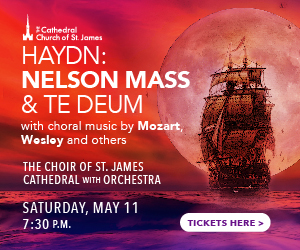Over the course of the 2013/14 concert season I wrote several columns about the challenge that choirs face when programming new music: how to get audiences to risk the price of a ticket on repertoire that is not tried and true, safe and familiar.
One final observation to sum up this theme, before the summer break: most new music for choral ensembles that is not strictly popular falls into the category of “extended tonality.” What exactly is extended tonality?
Twentieth-century music can be viewed as a kind of pitched battle between composers whose work dispensed with the idea that music ought to have a key centre that could help orient the listener and composers who kept elements of traditional harmony and melody even when they were venturing into more experimental territory. The so-called “Second Viennese School” – Schoenberg, Berg, Webern – who began writing what is confusedly known as atonal music and later composers that built on their work, such as Babbitt, Boulez and Stockhausen, are examples of the former, Stravinsky, Britten and Shostakovich, of the latter.
There were many other categories, sub-genres and trends, but very broadly, these were the two opposing camps of musical endeavour that emerged out of the European classical tradition.
Extended tonality won.
It won in the sense that younger composers generally did not pick up on the atonal experiment in music, and this musical strain now appears to be going the way of cool jazz and the songs of the German meistersingers – intellectually-driven styles that ran aground and seem to have little current appeal to revivalists. Late 20th-century composers did not want to leave behind rock, jazz and world music, influences that operate almost entirely in a tonal framework. Their insistence on integrating these influences in their music placed them firmly in the tradition of earlier composers who had integrated various types of popular music into their sophisticated compositions.
What does this mean for listeners? Looking at this year’s new composition programming in retrospect, I can state that none of it was music that ought to have sent anyone but the most timid listeners screaming for the exit. So, are you willing to take a chance on something new, knowing that it is not likely to be that weird?
Speaking as someone who will order fish and chips for lunch, dinner or breakfast if possible, I hesitate to be overly judgemental about anyone’s musical menu choices. But it’s time to recognize that we’re living in an era in which composers are reaching out to listeners with alacrity as well as skill and insight. We’re well past the point at which we should be thinking of new music with hostility. So I hope you’ll give some of it a chance this summer, and in the new season as well. Below is a selection of concerts taking place from June to August.
The Ontario Youth Choir was founded in 1971 by the choral organization Choirs Ontario. TheOYC quickly became a vital instrument for generating enthusiasm for choral music among young singers, and for providing an important bridge between children’s choirs and adult ensembles. Each summer 40 talented young singers are auditioned and selected to take part in two weeks of rehearsals, masterclasses and voice lessons, culminating in a short three-city cross-Ontario tour and several concerts. The ensemble is conducted by a different Ontario director each summer. This year Guelph University’s Dr. Marta McCarthy leads the OYC in concerts in Toronto and Midland.
The Open Ears Festival is a great event to attend for those interested in new music – it’s one of my favourite new music festivals around, in part because it always conveys a sense of fun and irreverence in its programming. The Da Capo Chamber Choir will be taking part in the festival with concerts on June 7 and 8. For more information about the festival in general, see openears.ca.
On June 8 and 14 the Kokoro Singers will be performing inGuelph and Dundas, respectively. Their concert “Celebration of Canadian Composers” features several composers – Mark Sirett, Donald Patriquin and Stephen Chatman among them – who are the most listener-friendly in the country. If you’re looking to ease your way into new music, this is a very good place to start.
On June 11 the Hamilton Children’s Choir performs “Together as One”; the concert is in support of the choir’s tour to Korea.
On June 20 the Adelphi Vocal Ensemble performs“Music for St. John’s Eve,” a concert of English choral music that includes Vaughan Williams’ Mass in G Minor, as well as selections by Tallis and early-20th century composers Harwood and Naylor. The Vaughan Williams mass is an appealing and historically important work that is always worth hearing live.
Speaking of historically significant, this summer Ontarians have two chances to hear the Choir of Trinity College Cambridge. This ensemble dates as far back as the 14th century and has past associations with important composers and conductors. The choir will be performing at the Elora Festival on July 13 and at the Westben Arts Festival on July 19.
On June 7 and 8 the University of Waterloo’s Conrad Grebel University College choirs will perform “Sound in the Land: Music and the Environment: Kalahari Journey,” a choral initiative that is part of a larger environmental project to understand the nature of the earth through the medium of sound. The event involves workshops, lectures and events as well as concerts. More information can be found at uwaterloo.ca/grebel/sound-land-2014/about.
Finally, check out the Festival of the Sound in Parry Sound for performances of Rachmaninoff’s Vespers by the Elora Festival Singers on July 29 and of Beethoven’s Ninth Symphony by the Elmer Isler Singers on August 10. The Elora Festival Singers will also be performing several exciting-sounding concerts at their own festival, notably David Fanshawe’s celebrated African Sanctus on July 12.
Benjamin Stein is a Toronto tenor and lutenist. He can be contacted at choralscene@thewholenote.com. Visit his website at benjaminstein.ca.




